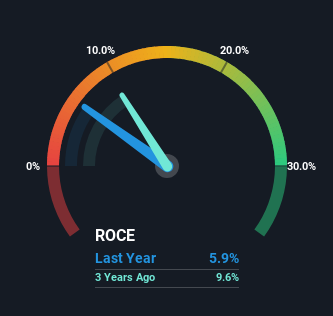
If we want to find a potential multi-bagger, often there are underlying trends that can provide clues. Firstly, we'll want to see a proven return on capital employed (ROCE) that is increasing, and secondly, an expanding base of capital employed. This shows us that it's a compounding machine, able to continually reinvest its earnings back into the business and generate higher returns. In light of that, when we looked at Metallurgical Corporation of China (HKG:1618) and its ROCE trend, we weren't exactly thrilled.
Return On Capital Employed (ROCE): What Is It?
If you haven't worked with ROCE before, it measures the 'return' (pre-tax profit) a company generates from capital employed in its business. Analysts use this formula to calculate it for Metallurgical Corporation of China:
Return on Capital Employed = Earnings Before Interest and Tax (EBIT) ÷ (Total Assets - Current Liabilities)
0.059 = CN¥14b ÷ (CN¥725b - CN¥497b) (Based on the trailing twelve months to September 2024).
Therefore, Metallurgical Corporation of China has an ROCE of 5.9%. Even though it's in line with the industry average of 5.9%, it's still a low return by itself.
Check out our latest analysis for Metallurgical Corporation of China

Above you can see how the current ROCE for Metallurgical Corporation of China compares to its prior returns on capital, but there's only so much you can tell from the past. If you'd like, you can check out the forecasts from the analysts covering Metallurgical Corporation of China for free.
So How Is Metallurgical Corporation of China's ROCE Trending?
In terms of Metallurgical Corporation of China's historical ROCE movements, the trend isn't fantastic. Over the last five years, returns on capital have decreased to 5.9% from 9.3% five years ago. Given the business is employing more capital while revenue has slipped, this is a bit concerning. This could mean that the business is losing its competitive advantage or market share, because while more money is being put into ventures, it's actually producing a lower return - "less bang for their buck" per se.
On a separate but related note, it's important to know that Metallurgical Corporation of China has a current liabilities to total assets ratio of 69%, which we'd consider pretty high. This can bring about some risks because the company is basically operating with a rather large reliance on its suppliers or other sorts of short-term creditors. Ideally we'd like to see this reduce as that would mean fewer obligations bearing risks.
The Bottom Line
In summary, we're somewhat concerned by Metallurgical Corporation of China's diminishing returns on increasing amounts of capital. However the stock has delivered a 43% return to shareholders over the last five years, so investors might be expecting the trends to turn around. Regardless, we don't feel too comfortable with the fundamentals so we'd be steering clear of this stock for now.
On a final note, we've found 2 warning signs for Metallurgical Corporation of China that we think you should be aware of.
While Metallurgical Corporation of China isn't earning the highest return, check out this free list of companies that are earning high returns on equity with solid balance sheets.
Have feedback on this article? Concerned about the content? Get in touch with us directly. Alternatively, email editorial-team (at) simplywallst.com.
This article by Simply Wall St is general in nature. We provide commentary based on historical data and analyst forecasts only using an unbiased methodology and our articles are not intended to be financial advice. It does not constitute a recommendation to buy or sell any stock, and does not take account of your objectives, or your financial situation. We aim to bring you long-term focused analysis driven by fundamental data. Note that our analysis may not factor in the latest price-sensitive company announcements or qualitative material. Simply Wall St has no position in any stocks mentioned.